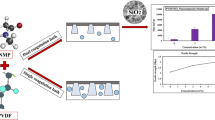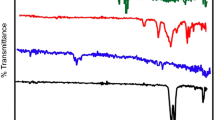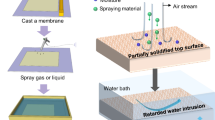Abstract
A superhydrophobic and nanofibrous high-impact polystyrene (HIPS) membrane was fabricated using electroblowing technique. The neat HIPS membrane was then subjected to the hot-pressing process to increase mechanical strength, narrowing pore size distribution, and also improving liquid entry pressure of water (LEP). The membrane characteristics (surface morphology, hydrophobicity, LEP, porosity, as well as mechanical properties) and direct contact membrane distillation (DCMD) performance (permeate flux and dye rejection factor) of the fabricated membranes were assessed using synthetic disperse dye solutions (0.4, 0.8 and 1.2 g/L) under constant DCMD condition. HIPS membranes maintained their durability even after operating at the highest concentration. The obtained results demonstrated that the dye removals were higher than 99.8% when different concentrations of dye were used as the feed. The permeate flux decline and surface fouling were increased by increasing the feed concentration. However, the surface contact angle of membranes subjected to DCMD tests was still in the range of hydrophobic surface (˃ 90°). Given these attributes, nanofibrous HIPS membrane can be considered as a potential alternative for membrane distillation in dying water treatment. Furthermore, DCMD can utilize the high temperature of dyeing baths as a viable heat source.








Similar content being viewed by others
Abbreviations
- COD:
-
Chemical oxygen demand
- CTAB:
-
Cetyl trimethyl ammonium bromide
- DCMD:
-
Direct contact membrane distillation
- DI water:
-
Deionized water
- DMF:
-
Dimethylformamide
- EB:
-
Elongation at break
- EC:
-
Electrical conductivity
- ELB:
-
Electroblowing
- ES:
-
Electrospinning
- FD:
-
Flux decline
- H-60:
-
Neat HIPS membrane
- HIPS:
-
High-impact polystyrene
- HP-60:
-
Hot-pressed HIPS membrane
- IPA:
-
Isopropyl alcohol
- LEP:
-
Liquid entry pressure of water
- MD:
-
Membrane distillation
- MF:
-
Microfiltration
- NF:
-
Nanofiltration
- PS:
-
Polystyrene
- PVDF:
-
Polyvinylidene fluoride
- PTFE:
-
Polytetrafluoroethylene
- SAN:
-
Styrene-acrylonitrile
- SEM:
-
Scanning electron microscope
- TS:
-
Tensile strength
- UF:
-
Ultrafiltration
- WCA:
-
Water contact angle
- WPC:
-
Water production cost
- A :
-
Membrane effective area
- J :
-
Flux
- k :
-
Thermal conductivity
- r :
-
Mean pore size
- R (%):
-
Rejection factor (%)
- t :
-
DCMD operating time
- W :
-
Weight
- ρ :
-
Density
- ε :
-
Porosity
- δ :
-
Thickness
- ∆:
-
Difference
- D:
-
Dry
- f:
-
Feed
- g:
-
Air or water vapor
- i:
-
IPA
- m:
-
Membrane
- max:
-
Maximum
- p:
-
Permeate or polymer
- s:
-
Polymer
- t:
-
At a given time
- W:
-
Wet
- 0:
-
Initial time
- 1:
-
Feed containing 0.4 g/L dye
- 2:
-
Feed containing 0.8 g/L dye
- 3:
-
Feed containing 1.2 g/L dye
References
Alkhudhiri A, Darwish N, Hilal N (2012) Membrane distillation: a comprehensive review. Desalination 287:2–18. https://doi.org/10.1016/j.desal.2011.08.027
Al-Obaidani S, Curcio E, Macedonio F, Di Profio G, Al-Hiani H, Drioli E (2008) Potential of membrane distillation in seawater dealination: thermal efficiency, sensitivity analysis and cost estimation. J Membr Sci. https://doi.org/10.1016/j.memsci.2008.06.006
Aminyan R, Bazgir S (2019) Fabrication and characterization of nanofibrous polyacrylic acid superabsorbent using gas-assisted electrospinning technique. React Funct Polym 141:133–144. https://doi.org/10.1016/j.reactfunctpolym.2019.05.012
An AK, Guo J, Lee EJ, Jeong S, Zhao Y, Wang Z, Leiknes T (2017) PDMS/PVDF hybrid electrospun membrane with superhydrophobic property and drop impact dynamics for dyeing wastewater treatment using membrane distillation. J Membr Sci 525:57–67. https://doi.org/10.1016/j.memsci.2016.10.028
Chen Y, Lu KJ, Chung TS (2019) An omniphobic slippery membrane with simultaneous anti-wetting and anti-scaling properties for robust membrane distillation. J Membr Sci 595:117572. https://doi.org/10.1016/j.memsci.2019.117572
Criscuoli A, Zhong J, Figoli A, Carnevale MC, Huang R, Drioli E (2008) Treatment of dye solutions by vacuum membrane distillation. Water Res 42:5031–5037. https://doi.org/10.1016/j.watres.2008.09.014
Curcio E, Drioli E (2005) Membrane distillation and related operations-a review. Sep Purif Rev 34:35–86. https://doi.org/10.1081/SPM-200054951
Deka BJ, Lee EJ, Guo J, Kharraz J, An AK (2019) Electrospun nanofiber membranes incorporating PDMS-aerogel superhydrophobic coating with enhanced flux and improved antiwettability in membrane distillation. Environ Sci Technol 53:4948–4958. https://doi.org/10.1021/acs.est.8b07254
Dhale AD, Mahajani VV (2000) Studies in treatment of disperse dye waste: membrane-wet oxidation process. Waste Manag 20:85–92. https://doi.org/10.1016/s0956-053x(99)00276-7
Dong ZQ, Ma X, Xu ZL, You WT, Li F (2014) Superhydrophobic PVDF–PTFE electrospun nanofibrous membranes for desalination by vacuum membrane distillation. Desalination 347:175–183. https://doi.org/10.1016/j.desal.2014.05.015
Dos Santos WN, de Sousa JA, Gregorio R (2013) Thermal conductivity behaviour of polymers around glass transition and crystalline melting temperatures. Polym Test 32:987–994. https://doi.org/10.1016/j.polymertesting.2013.05.007
Duong HC, Duke M, Gray S, Cooper P, Nghiem LD (2016) Membrane scaling and prevention techniques during seawater desalination by air gap membrane distillation. Desalination 397:92–100. https://doi.org/10.1016/j.desal.2016.06.025
Duong HC, Chuai D, Woo YC, Shon HK, Nghiem LD, Sencadas V (2018) A novel electrospun, hydrophobic, and elastomeric styrene-butadiene-styrene membrane for membrane distillation applications. J Membr Sci 549:420–427. https://doi.org/10.1016/j.memsci.2017.12.024
El-Bourawi MS, Ding Z, Ma R, Khayet M (2006) A framework for better understanding membrane distillation separation process. J Membr Sci 285:4–29. https://doi.org/10.1016/j.memsci.2006.08.002
Eykens L, Hitsov I, De Sitter K, Dotremont C, Pinoy L, Nopens I, Van der Bruggen B (2016) Influence of membrane thickness and process conditions on direct contact membrane distillation at different salinities. J Membr Sci 498:353–364. https://doi.org/10.1016/j.memsci.2015.07.037
Eykens L, De Sitter K, Dotremont C, Pinoy L, Van der Bruggen B (2017) Membrane synthesis for membrane distillation: a review. Sep Purif Technol 182:36–51. https://doi.org/10.1016/j.seppur.2017.03.035
Garcia-Ivars J, Wang-Xu X, Iborra-Clar MI (2017) Application of post-consumer recycled high-impact polystyrene in the preparation of phase-inversion membranes for low-pressure membrane processes. Sep Purif Technol 175:340–351. https://doi.org/10.1016/j.seppur.2016.11.061
Gopal R, Kaur S, Ma Z, Chan C, Ramakrishna S, Matsuura T (2006) Electrospun nanofibrous filtration membrane. J Membr Sci 281:581–586. https://doi.org/10.1016/j.memsci.2006.04.026
Gryta M (2005) Long-term performance of membrane distillation process. J Membr Sci 265:153–159. https://doi.org/10.1016/j.memsci.2005.04.049
Hu Y, Qi C, Liu W, Wang B, Zheng H, Sun X, Zheng X (2003) Characterization of the free volume in high-impact polystyrene/polypropylene and high-impact polystyrene/ high-density polyethylene blends probed by positron annihilation spectroscopy. J Appl Polym Sci 90(2003):1507–1514. https://doi.org/10.1002/app.2379
Hou D, Ding C, Fu C, Wang D, Zhao C, Wang J (2019) Electrospun nanofibrous omniphobic membrane for anti-surfactant-wetting membrane distillation desalination. Desalination 468:114068. https://doi.org/10.1016/j.desal.2019.07.008
Jelčić Ž, Ranogajec F (2012) Radiation modified high impact polystyrene. Radiat Phys Chem 81:1366–1369. https://doi.org/10.1016/j.radphyschem.2011.11.044
Jiao L, Yan K, Wang J, Lin S, Li G, Bi F, Zhang L (2020) Low surface energy nanofibrous membrane for enhanced wetting resistance in membrane distillation process. Desalination 476:114210. https://doi.org/10.1016/j.desal.2019.114210
Jönsson AS, Wimmerstedt R, Harrysson AC (1985) Membrane distillation: a theoretical study of evaporation through microporous membranes. Desalination 56:237–249. https://doi.org/10.1016/0011-9164(85)85028-1
Kang M, Jung R, Kim HS, Jin HJ (2008) Preparation of superhydrophobic polystyrene membrane by electrospinning. Colloid Surf A Physicochem Eng Asp 313–314:411–414. https://doi.org/10.1016/j.colsurfa.2007.04.122
Ke H, Feldman E, Guzman P, Cole J, Wei Q, Chu B, Alkhudhiri A, Alrasheed R, Hsiao BS (2016) Electrospun polystyrene nanofibrous membranes for direct contact membrane distillation. J Membr Sci 515:86–97. https://doi.org/10.1016/j.memsci.2016.05.052
Khayet M (2013) Solar desalination by membrane distillation: dispersion in energy consumption analysis and water production costs (a review). Desalination 308:89–101. https://doi.org/10.1016/j.desal.2012.07.010
Kim HG, Park C, Yang J, Lee B, Kim SS, Kim S (2007) Optimization of backflushing conditions for ceramic ultrafiltration membrane of disperse dye solutions. Desalination 202:150–155. https://doi.org/10.1016/j.desal.2005.12.051
Kisku GC, Markandeya T, Shukla SP, Singh DS, Murthy RC (2015) Characterization and adsorptive capacity of coal fly ash from aqueous solutions of disperse blue and disperse orange dyes. Environ Earth Sci 74:1125–1135. https://doi.org/10.1007/s12665-015-4098-z
Lalia BS, Guillen-Burrieza E, Arafat HA, Hashaikeh R (2013) Fabrication and characterization of polyvinylidenefluoride-co-hexafluoropropylene (PVDF-HFP) electrospun membranes for direct contact membrane distillation. J Membr Sci 428:104–115. https://doi.org/10.1016/j.memsci.2012.10.061
Lau WJ, Ismail AF (2009) Polymeric nanofiltration membranes for textile dye wastewater treatment: preparation, performance evaluation, transport modeling, and fouling control—a review. Desalination 245:321–348. https://doi.org/10.1016/j.desal.2007.12.058
Lee EJ, An AK, Hadi P, Lee S, Woo YC, Shon HK (2017) Advanced multi-nozzle electrospun functionalized titanium dioxide/polyvinylidene fluoride-co hexafluoropropylene (TiO2/PVDF-HFP) composite membranes for direct contact membrane distillation. J Membr Sci 524:712–720. https://doi.org/10.1016/j.memsci.2016.11.069
Li D, Peng J, Zhai M, Qiao J, Zhang X, Wei G (2008) Novel methods for synthesis of high-impact polystyrene with bimodal distribution of rubber particle size. J Appl Polym Sci 109:2071–2075. https://doi.org/10.1002/app.24624
Li X, Wang C, Yang Y, Wang X, Zhu M, Hsiao BS (2014) Dual-biomimetic superhydrophobic electrospun polystyrene nanofibrous membranes for membrane distillation. ACS Appl Mater Interf 6:2423–2430. https://doi.org/10.1021/am4048128
Liao Y, Wang R, Fane AG (2013) Engineering superhydrophobic surface on poly(vinylidene fluoride) nanofiber membranes for direct contact membrane distillation. J Membr Sci 440:77–87. https://doi.org/10.1016/j.memsci.2013.04.006
Lin PJ, Yang MC, Li YL, Chen JH (2015) Prevention of surfactant wetting with agarose hydrogel layer for direct contact membrane distillation used in dyeing wastewater treatment. J Membr Sci 475:511–520. https://doi.org/10.1016/j.memsci.2014.11.001
Lu KJ, Zuo J, Chang J, Kuan HN, Chung TS (2018) Omniphobic hollow-fiber membranes for vacuum membrane distillation. Environ Sci Technol 52:4472–4480. https://doi.org/10.1021/acs.est.8b00766
Lu KJ, Chen Y, Chung TS (2019) Design of omniphobic interfaces for membrane distillation: a review. Water Res 162:64–77. https://doi.org/10.1016/j.watres.2019.06.056
Luo A, Lior N (2016) Critical review of membrane distillation performance criteria. Desalin Water Treat 57:20093–20140. https://doi.org/10.1080/19443994.2016.1152637
Malik SN, Ghosh PC, Vaidya AN, Mudliar SN (2020) Hybrid ozonation process for industrial wastewater treatment: principles and applications: a review. J Water Proc Eng 35:101193. https://doi.org/10.1016/j.jwpe.2020.101193
Markandeya SSP, Dhiman N, Mohan D, Kisku GC, Roy S (2017) An efficient removal of disperse dye from wastewater using zeolite synthesized from cenospheres. J Hazard Toxic Radioact Waste. https://doi.org/10.1061/(asce)hz.2153-5515.0000369
Mokhtar NM, Lau WJ, Ismail AF (2014a) The potential of membrane distillation in recovering water from hot dyeing solution. J Water Process Eng 2:71–78. https://doi.org/10.1016/j.jwpe.2014.05.006
Mokhtar NM, Lau WJ, Ng BC, Ismail AF, Veerasamy D (2014b) Preparation and characterization of PVDF membranes incorporated with different additives for dyeing solution treatment using membrane distillation. Desalin Water Treat 56:1999–2012. https://doi.org/10.1080/19443994.2014.959063
Mokhtar NM, Lau WJ, Ismail AF, Youravong W, Khongnakorn W, Lertwittayanon K (2015) Performance evaluation of novel PVDF–Cloisite 15A hollow fiber composite membranes for treatment of effluents containing dyes and salts using membrane distillation. RSC Adv 5:38011–38020. https://doi.org/10.1039/C5RA00182J
Mokhtar NM, Lau WJ, Ismail AF, Kartohardjono S, Lai SO, Teoh HC (2016) The potential of direct contact membrane distillation for industrial textile wastewater treatment using PVDF-Cloisite 15A nanocomposite membrane. Chem Eng Res Des 111:284–293. https://doi.org/10.1016/j.cherd.2016.05.018
Na H, Zhao Y, Zhao C, Zhao C, Yuan X (2008) Effect of hot-press on electrospun poly(vinylidene fluoride) membranes. Polym Eng Sci 48:934–940. https://doi.org/10.1002/pen.21039
Niknejad AS, Bazgir S, Sadeghzadeh A, Shirazi MMA (2020) Styrene-acrylonitrile (SAN) nanofibrous membranes with unique properties for desalination by direct contact membrane distillation (DCMD) process. Desalination 488:114502. https://doi.org/10.1016/j.desal.2020.114502
Nuraje N, Khan WS, Lei Y, Ceylan M, Asmatulu R (2013) Superhydrophobic electrospun nanofibers. J Mater Chem A 1:1929–1946. https://doi.org/10.1039/C2TA00189F
Pangarkar BL, Sane MG, Parjane SB, Guddad M (2014) Status of membrane distillation for water and wastewater treatment-a review. Desalin Water Treat 52:5199–5218. https://doi.org/10.1080/19443994.2013.808422
Pearce CI, Lloyd JR, Guthrie JT (2003) The removal of colour from textile wastewater using whole bacterial cells: a review. Dyes Pigment 58:179–196. https://doi.org/10.1016/S0143-7208(03)00064-0
Prince J, Singh G, Rana D, Matsuura T, Anbharasi V, Shanmugasundaram T (2012) Preparation and characterization of highly hydrophobic poly(vinylidene fluoride)–clay nanocomposite nanofiber membranes (PVDF–clay NNMs) for desalination using direct contact membrane distillation. J Membr Sci 397–398:80–86. https://doi.org/10.1016/j.memsci.2012.01.012
Ramlow H, Machado RAF, Bierhalz ACK, Marangoni C (2018) Dye synthetic solution treatment by direct contact membrane distillation using commercial membranes. Environ Technol. https://doi.org/10.1080/09593330.2018.1561758
Ramlow H, D’Ávila Kramer Cavalcanti C, Machado RAF, Krause Bierhalz AC, Marangoni C (2019) Direct contact membrane distillation applied to colored reactive or disperse dye solutions. Chem Eng Technol 42:1045–1052. https://doi.org/10.1002/ceat.201800468
Ranjbari E, Bazgir S, Shirazi MMA (2020) Needleless electrospinning of poly(acrylic acid) superabsorbent: fabrication, characterization and swelling behavior. Polym Test 84:106403. https://doi.org/10.1016/j.polymertesting.2020.106403
Sadeghzadeh A, Bazgir S, Shirazi MMA (2020) Fabrication and characterization of a novel hydrophobic polystyrene membrane using electroblowing technique for desalination by direct contact membrane distillation. Sep Purif Technol 239:116498. https://doi.org/10.1016/j.seppur.2019.116498
Seyed Shahabadi SM, Rabiee H, Seyedi SM, Mokhtare A, Brant JA (2017) Superhydrophobic dual layer functionalized titanium dioxide/polyvinylidene fluoride-co-hexafluoropropylene (TiO2/PH) nanofibrous membrane for high flux membrane distillation. J Membr Sci 537:140–150. https://doi.org/10.1016/j.memsci.2017.05.039
Shahhosseininia M, Bazgir S, Joupari MD (2018) Fabrication and investigation of silica nanofibers via electrospinning. Mater Sci Eng C 91:502–511. https://doi.org/10.1016/j.msec.2018.05.068
Shirazi MMA, Kargari A, Bazgir S, Tabatabaei M, Shirazi MJA, Abdullah MS, Matsuura T, Ismail AF (2013) Characterization of electrospun polystyrene membrane for treatment of biodiel’s water-washing effluent using atomic force microscopy. Desalination 329:1–8. https://doi.org/10.1016/j.desal.2013.08.019
Shirazi MMA, Kargari A, Tabatabaei M (2014) Evaluation of commercial PTFE membranes in desalination by direct contact membrane distillation. Chem Eng Process Intensif 76:16–25. https://doi.org/10.1016/j.cep.2013.11.010
Shirazi MMA, Bazgir S, Meshkani F (2020) A novel dual-layer, gas-assisted electrospun, nanofibrous SAN4-HIPS membrane for industrial textile wastewater treatment by direct contact membrane distillation (DCMD). J Water Process Eng 36:101315. https://doi.org/10.1016/j.jwpe.2020.101315
Song Y, Sun Y, Chen M, Huang P, Li T, Zhang X, Jiang K (2020) Efficient removal and fouling-resistant of anionic dyes by nanofiltration membrane with phosphorylated chitosan modified grapheme oxide nanosheets incorporated selective layer. J Water Process Eng 34:101086. https://doi.org/10.1016/j.jwpe.2019.101086
Tijing LD, Woo YC, Johir MAH, Choi JS, Shon HK (2014a) A novel dual-layer bicomponent electrospun nanofibrous membrane for desalination by direct contact membrane distillation. Chem Eng J 256:155–159. https://doi.org/10.1016/j.cej.2014.06.076
Tijing LD, Choi JS, Lee S, Kim SH, Shon HK (2014b) Recent progress of membrane distillation using electrospun nanofibrous membrane. J Membr Sci 453:435–462. https://doi.org/10.1016/j.memsci.2013.11.022
Van der Bruggen B, Canbolat ÇB, Lin J, Luis P (2017) The potential of membrane technology for treatment of textile wastewater. In: Figoli A, Criscuoli A (eds) Sustainable membrane technology for water and wastewater treatment: Green Chemistry and Sustainable Technology. Springer, Singapore. https://doi.org/10.1007/978-981-10-5623-9_13
Vergili I, Kaya Y, Sen U, Gonder ZB, Aydiner C (2012) Technolo-economic analysis of textile dye bath wastewater treatment by integrated membrane processes under the zero liquid discharge approach. Resour Convserv Recycl 58:25–35. https://doi.org/10.1016/j.resconrec.2011.10.005
Wang Z, Jin J, Hou D, Lin S (2016) Tailoring surface charge and wetting property for robust oil-fouling mitigation in membrane distillation. J Membr Sci 518:113–122. https://doi.org/10.1016/j.memsci.2016.06.011
Wang K, Abdalla AA, Khaleel MA, Hilal N, Kharaisheh MK (2017) Mechanical properties of water desalination and wastewater treatment membranes. Desalination 401:190–205. https://doi.org/10.1016/j.desal.2016.06.032
Woo YC, Tijing LD, Park MJ, Yao M, Choi JS, Lee S, Kim SH, An KJ, Shon HK (2017) Electrospun dual-layer nonwoven membrane for desalination by air gap membrane distillation. Desalination 403:187–198. https://doi.org/10.1016/j.desal.2015.09.009
Wypych G (2016) Handbook of polymers. Chemtec publishing, Toronto
Yao M, Woo YC, Tijing LD, Shim WG, Choi JS, Kim SH, Shon HK (2016) Effect of heat-press conditions on electrospun membranes for desalination by direct contact membrane distillation. Desalination 378:80–91. https://doi.org/10.1016/j.desal.2015.09.025
Zhan N, Li Y, Zhang C, Song Y, Wang H, Sun L, Yang Q, Hong X (2010) A novel multinozzle electrospinning process for preparing superhydrophobic PS films with controllable bead-on-string/microfiber morphology. J Colloid Interface Sci 345:491–495. https://doi.org/10.1016/j.jcis.2010.01.051
Zhang Y, Peng Y, Ji S, Li Z, Chen P (2015) Review of thermal efficiency and heat recycling in membrane distillation processes. Desalination 367:223–239. https://doi.org/10.1016/j.desal.2015.04.013
Zhang Z, Du X, Carlson KH, Robbins CA, Tong T (2019) Effective treatment of shale oil and gas produced water by membrane distillation coupled with precipitative softening and walnut shell filtration. Desalination 454:82–90. https://doi.org/10.1016/j.desal.2018.12.011
Zulfi A, Munir MM, Hapidin DA, Rajak A, Edikresnha D, Iskandar F, Khairurrijal K (2018) Air filtration media from electrospun waste high-impact polystyrene fiber membrane. Mater Res Express 5:035049. https://doi.org/10.1088/2053-1591/aab6ef
Acknowledgements
The authors want to acknowledge Mr. Amirhossein Sadeghzadeh for his valuable practical comments and efforts in the nanopolymer laboratory of the SRBIAU.
Author information
Authors and Affiliations
Corresponding author
Ethics declarations
Conflict of interest
The authors declare that they have no conflict of interest.
Additional information
Editorial responsibility: Samareh Mirkia.
Rights and permissions
About this article
Cite this article
Khoshnevisan, S., Bazgir, S. Treatment of dye wastewater by direct contact membrane distillation using superhydrophobic nanofibrous high-impact polystyrene membranes. Int. J. Environ. Sci. Technol. 18, 1513–1528 (2021). https://doi.org/10.1007/s13762-020-02894-8
Received:
Revised:
Accepted:
Published:
Issue Date:
DOI: https://doi.org/10.1007/s13762-020-02894-8




